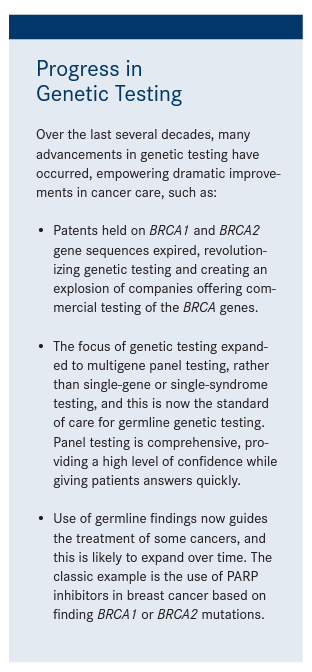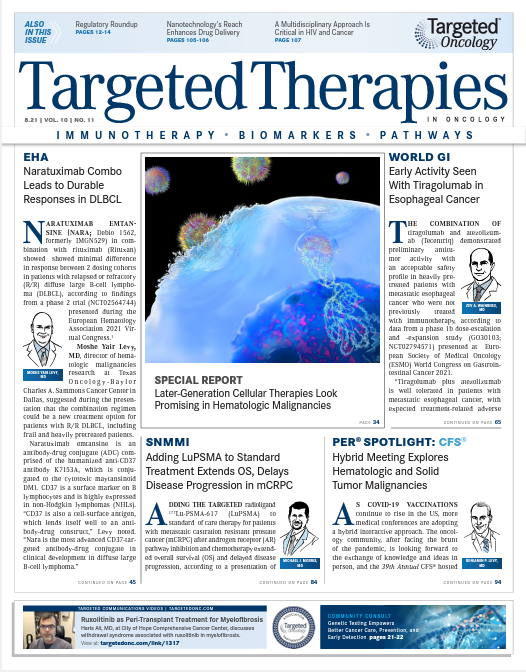Genetic Testing Empowers Better Cancer Care, Prevention, and Early Detection
Today, many community oncology practices routinely employ genetic testing, enabling newly diagnosed patients and their oncologists to make treatment decisions and to formulate preventive strategies based on genetic information.
Lucy Langer, MD

Germline genetic testing is a critical component of comprehensive, high-quality cancer care. Genetic testing is no longer just the purview of academic institutions. As we have learned more about the genetic alterations that can lead to cancer, germline genetic testing has diffused across the health care landscape. Today, many community oncology practices routinely employ genetic testing, enabling newly diagnosed patients and their oncologists to make treatment decisions and to formulate preventive strategies based on genetic information.
Because genetic testing is starting to permeate the treatment space, the argument can be made that without offering this service, practices are not providing complete cancer care. Many may want to offer testing but are intimidated by setting up a program. The US Oncology Network (The Network) has simplified this often-complex undertaking by creating the Genetic Risk Evaluation and Testing (GREAT) program. GREAT empowers practices to efficiently implement genetic testing based on best practices, putting this critical component of cancer care easily within the reach of practices of all sizes. A close-up look at the program and how practices can employ this innovative framework will provide insight for those considering a genetic testing initiative. It is also worthwhile to review advancements in genetic testing to better understand how it has become such a vital part of cancer care.
Preventing Cancer, Not Just Treating It
Although germline genetic testing can play a key role in the treatment of certain cancers, at the current time it plays an even more important role in the prevention or early detection of cancer. It is the goal of oncologists to not only provide high-quality cancer care, but also ultimately to prevent cancer altogether. When oncology practices offer testing and evaluation services, such as the GREAT program, they can do more than just treat the disease. Testing provides an opportunity to develop cancer prevention and early detection strategies for patients and their at-risk family members. For those with mutations, there are preventive, early detection, and patient management guidelines that can be employed. For patients without a hereditary mutation, a family history evaluation and full genetic consultation can help develop an appropriate personalized prevention or surveillance plan.
Clinic-based genetics services remain the gold standard. Direct-to-consumer (DTC) genetic tests have become more prominent in the market. These tests commonly evaluate markers of ancestry with little attention to personal or family history of cancer. Many DTC tests also provide a report of single nucleotide polymorphisms (SNPs) which are then analyzed in the secondary market for everything from cancer risk to food sensitivity to markers of diseases like schizophrenia or Alzheimer’s.
The testing and analysis are rarely covered by insurance plans. Furthermore, the quality of these tests, the interpretation of the data, and the information they provide can be highly variable. Some of these DTC tests can seem to be a comprehensive test for cancer genes, when in reality they are not. Other DTC tests provide more comprehensive testing for cancer genes but are newer to the genetic testing space. These companies have less experience interpreting abnormal findings. As a result, it can lead to a devastating clinical consequence for individual consumers who receive misinformation from the test, and without appropriate counseling may take inappropriate action, or no action at all, in response to that information.
To ensure accuracy and completeness, testing and evaluation need to be done by highly skilled professionals who can provide careful assessment, counseling, and accurately interpret the results. Community oncology practices, in partnership with experienced and proven laboratories, are ideally situated to provide these comprehensive services. Good oncology practices need to invest in the expertise needed to provide comprehensive care to the patient and their family members.
The GREAT Program
Developed in 2007 by physicians in The Net-work with advanced genetic expertise, the GREAT program is changing lives by providing more opportunities for cancer prevention and early detection. In 2020 alone, more than 21,500 patients received genetic consultations at 14 GREAT practices across The Net-work with an 8% mutation identification rate.
Working with program experts, the following key components of GREAT can be adapted to meet the needs of individual practices: initial consultation to gather family history and provide patient education; risk evaluation; appropriate genetic testing; follow-up consultations, educate the patient, and address concerns; individualized care plan for patients; and counseling of family members.

Implementation Steps to Build a Program
The flexibility of the GREAT program provides a “plug-and-play” approach that enables practices to select the most appropriate framework for the administrative and support processes required to successfully run a germline genetics program.
The implementation steps, which must be thought through carefully, include the following:
Determine how the program will be delivered.
Practices in The Network can select the delivery model that best suits them from several models The Network supports. A common entry model is to have an oncologist who has training in genetics provide testing and counseling for patients in need of these services.
However, oncologists are often busy, and adding genetic counseling can use up precious clinic time. Eventually, as the number of genetics referrals increases, the practice should consider hiring either a certified genetic counselor or an advanced practice provider with training in cancer genetics as a patient resource.
Develop an organized approach for gathering and analyzing patient information.
Once the delivery model is selected, practices must create procedures for gathering patient information. Some practices use a 2-hour visit, gathering health information and family history the first hour, and evaluating risk and providing education during the second hour. Other practices have patients provide information online before coming to the clinic. The Network utilizes a software package from CRA Health (now part of Volpara Health Technologies), which allows for the creation of a Health Insurance Portability and Account-ability Act-compliant repository of patient and family information linked with genetic test results and risk calculations. The information gathered before the genetics consultation can be managed by a dedicated administrator, who is also responsible for patient outreach, troubleshooting, and scheduling.
Establish laboratory procedures.
Next, practices must determine how to draw the lab test and where it will be processed. Some conduct tests in house, whereas others utilize outside labs. Either way, procedures must be developed to ensure an efficient process.
Determine how test results will be communicated to the patient.Finally, decisions must be made about how to discuss test results with the patient and at-risk family members, as well as how to edu-cate them and address any concerns they may have. The increasing use of telehealth across health care has decreased the geographic barriers to in-person visits and allows for a more streamlined genetics program.
The GREAT program takes a layered approach, providing different process templates to smaller practices with fewer resources, vs bigger practices with more resources. For example, a smaller practice without a genetics administrator receives different templates for schedulers than a larger practice would, helping staff understand how to book these patients in different settings. Different templates are also provided for laboratory work, so staff knows how to draw the lab and where it will be processed. Practices with a genetics administrator receive templates with different processes, enabling efficient integration with schedulers, the lab, the genetic counselor, and the oncologist.
Regardless of the practice size, implementing the GREAT program is a relatively straightforward, simple process. Many resources and program experts are avail-able and easily accessed to help develop the program and seamlessly integrate it into a practice.
Ongoing Education: The Crown Jewel of the GREAT Program
The US Oncology Network is committed to ensuring all practices in The Network have access to opportunities that expand their knowledge and skills surrounding genetic testing and evaluation. A wide range of educational activities are available to enhance the knowledge base of physicians and staff. The Network takes great pride in its educational program and has collaborated with City of Hope—the premier provider of genetic education programs—to develop its offerings.
The Network hosts a large educational conference annually for its practices, as well as others who are interested in genetic testing. Ongoing gene of the month seminars and case presentations provide additional learning opportunities. Activities are designed with community oncology practices in mind and include tips on outreach within communities, suggestions for providing local education to referring providers, and integration into a multispecialty practice.
Advancements on the Horizon
Many exciting advancements in genetic testing are on the horizon. Testing will likely focus more on combinations of SNPs in the future, rather than a single gene mutation. These single-site alterations in a gene, when taken individually, may not lead to cancer, but when taken collectively as a specific set of alterations may be harmful.
In addition, some companies are expand-ing into whole exome sequencing, which can be effective in detecting very rare dis-eases. Companies are also offering tests of the RNA, examining how genes are trans-lated in the cell. The value of these tests to patients and to the health care system overall remains to be determined.
Finally, in the near future, there will likely be much more germline testing that involves tissue. Paired testing of a tumor with surrounding normal tissue or concur-rent testing of white blood cells will examine not just somatic tumor gene alterations that may drive targeted treatment choices, but also the germline gene mutations. Combined testing will likely become much more prominent in the coming years.
Going Beyond Just Treating the Disease
Germline genetic testing should be part of everyday cancer care. Not long ago, patients were afraid of genetic discrimination, and many physicians were reluctant to pursue testing because of concerns about possible litigation. Today, most states have legislation in place protecting patients, and concerns around testing and discrimination have faded.
Germline genetic testing is a critical component of comprehensive, high-quality cancer care. Understanding of a patient’s underlying germline risk can improve the treatment of the patient’s cancer and provide valuable information for future risk reduction, both for the patient and their family members. It is important for physicians to think about how they can empower patients and family members to better understand the current diagnosis and to stop cancer in its tracks.
